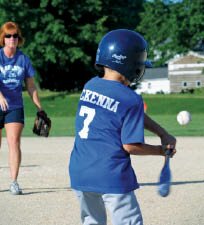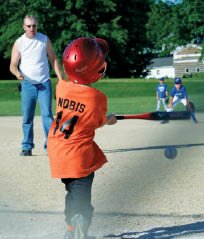
Discover rewarding casino experiences. 

Please Don't Quote Me PART II — CARROLL COUNTY GAZETTE February 7, 1874 “Office in the Post Office Block - $2.00 a year |
SPORTSBy Craig Lang, Prairie Advocate SportsPhotos
Milledgeville Pee Wee’s Ashton Nobis takes a big cut at a pitch during last Wednesday’s action in Lanark. The Milledgeville squad fell to Lanark1 13-11. (PA photo/Craig Lang)
Lanark1’s Riley McKenna keeps his eye on the pitch as he takes a big swing during last Wednesday’s Pee Wee action at EHS. The Lanark1 team took the game by two runs. (PA photo/Craig Lang) SPORTS . . . How Things Have Changed - Part 21901: Catchers were compelled to remain continuously under the bat. 1904: The height of the pitcher’s mound was limited to 15” higher than the level of the baselines or home plate. Pitchers are prohibited from soiling a new baseball. 1908: The sacrifice fly rule is adopted. 1910: The cork center is added to the official baseball. 1917: The spitball is outlawed 1920: A base runner may not run the bases in reverse order. Runs batted in are included in the official score. 1925: The minimum home run distance is set at 250 feet. Pitchers are allowed to use the rosin bag. 1935: The first night game is played on May 24th in Cincinnati. The first umpire school is opened in Hot Springs, Arkansas. 1953: Players are to remove their gloves from the field when at bat and no equipment is to show on the field at any time. 1959: Minimum boundaries are set for all new ball parks – 325’-400’-325’. 1969: The pitcher’s mound is dropped 5 inches. The save rule for relief pitcher’s is added. 1971: Protective helmets are to be worn by all batters. 1973: The designated hitter rule is added by the American League on a three year trial basis. The National League opposes the rule. 1974: Baseballs are permitted to be covered in cowhide because of the shortage of horses. 1976: The designated hitter rule becomes permanent in the American League. The National League still opposes the rule. 1988: Protective helmets become mandatory for all catchers. Carroll County Summer League TournamentsGirl’s League ResultsTiny Miss Girl’s (at Stockton)June 25 Stockton defeated Milledgeville Mt. Carroll defeated Chadwick Lanark defeated Thomson June 27 Stockton defeated Polo Shannon defeated Pearl City2 Savanna defeated Mt. Carroll Lanark defeated Pearl City1 June 28 Shannon defeated Stockton Savanna defeated Lanark June 30-Championship Savanna defeated Shannon Junior Miss Girl’s (at Pearl City)June 25 River Ridge defeated Savanna June 27 Pearl City defeated River Ridge Shannon defeated Stockton Milledgeville defeated Mt. Carroll/Thomson Lanark defeated Chadwick June 28 Pearl City defeated Milledgeville Shannon defeated Lanark June 29-Championship Pearl City defeated Shannon Senior Miss Girl’sJune 25 Thomson 17 Shannon 14 Stockton 22 Savanna 6 River Ridge defeated Lanark June 27 Pearl City1 defeated Thomson Milledgeville defeated Mt. Carroll June 28 River Ridge defeated Pearl City2 Stockton defeated Chadwick June 29 Pearl City1 defeated Milledgeville River Ridge defeated Stockton June 30-Championship Pearl City1 defeated River Ridge Little Miss Girl’s (at Lanark)June 25 Savanna defeated Chadwick Polo defeated Stockton2 Pearl City1 defeated Pearl City2 Shannon defeated Mt. Carroll/Thomson June 27 Milledgeville defeated Pearl City1 Stockton1 defeated Polo Lanark defeated Savanna June 28 Lanark defeated Shannon Milledgeville defeated Stockton1 June 30-Championship Milledgeville defeated Lanark Boys League SchedulePee Wee Boy’ (at Savanna)July 9 1-Mt. Carroll vs. Pearl City1 2-Savanna vs. Thomson 3-Lanark1 vs. Lanark2 4-Shannon vs. Pearl City2 July 11 5-Chadwick vs. game #2 winner 6-Milledgeville vs. game #1 winner July 12 7-Game #4 winner vs. game #5 winner July 13 Game #3 winner vs. game #6 winner July 14-Championship Game #7 winner vs. game #8 winner Small Fry Boy’s (at Mt. Carroll)July 11 1-Mt. Carroll vs. Pearl City2 2-Shannon vs. Savanna2 3-Lanark1 vs. Thomson July 12 4-Chadwick vs. Savanna1 5-Lanark2 vs. game #3 winner 6-Milledgeville vs. game #1 winner 7-Pearl City1 vs. game #2 winner July 13 8-Game #4 winner vs. game #6 winner 9-Game #5 winner vs. game #7 winner July 14-Championship 10-Game #8 winner vs. game #9 winner Junior Boy’s (at Chadwick)July 9 1-Chadwick vs. Savanna 2-Milledgeville vs. Thomson 3-Lanark vs. Mt. Carroll July 11 4-Shannon vs. game #1 winner July 12 5-Game #2 winner vs. game #3 winner July 13-Championship 6-Game #4 winner vs. game #5 winner Senior Boy’s (at Albany)July 12 1-Albany vs. Savanna July 13 2-Fulton vs. Mt. Carroll 3-Pearl City vs. Shannon July 14 4-Chadwick vs. game #1 winner 5-Game #2 winner vs. game #3 winner July 15-Championship 6-Game #4 winner vs. game #5 winner 2011 HS Football SchedulesNUIC-Northwest DivisionEPC WildcatzHead Coach: Randy Asche 2010 Record: 9-2 (2A) August 26 - vs. West Carroll at Pearl City September 2 - at Pecatonica September 9 - vs. Polo at Pearl City September 16 - vs. Galena at Lanark September 23 - at Le-Win September 30 - at East Dubuque October 7 - vs. South Beloit at Lanark October 14 - vs. Dakota at Lanark October 21 - at Forreston West Carroll ThunderHead Coach: Michael Bicksler 2010 Record: 4-5 (2A) August 26 - vs. EPC at Pearl City September 2 - vs. AFC September 9 - at Pecatonica September 16 - at Le-Win September 23 - vs. South Beloit September 30 - vs. Dakota October 8 - at Forreston October 14 - vs. Galena October 21 - at Polo Forreston CardinalsHead Coach: Denny Diduch 2010 Record: 6-4 (1A) August 26 - at Galena September 2 - vs. Dakota September 9 - vs. South Beloit September 16 - at Orangeville September 23 - at Polo September 30 - vs. Le-Win October 8 - vs. West Carroll October 14 - at Pecatonica October 21 - vs. EPC Polo MarcosHead Coach: Andrew Hofer 2010 Record: 4-5 (1A) August 26 - at Milledgeville September 2 - vs. Galena September 9 - vs. EPC at Pearl City September 16 - at Dakota September 23 - vs. Forreston September 30 - at Pecatonica October 7 - vs. Le-Win October 14 - at South Beloit October 21 - vs. West Carroll Le-Win PanthersHead Coach: Ric Arand 2010 Record: 13-1 (1A) August 26 - vs. Pecatonica September 2 - at South Beloit September 9 - at Galena September 16 - vs. West Carroll September 23 - vs. EPC September 30 - at Forreston October 7 - at Polo October 14 - vs. Stockton October 21 - at Dakota Dakota IndiansHead Coach: Jerry Lano 2010 Record: 9-2 (1A) August 26 - vs. South Beloit September 2 - at Forreston September 9 - at Freeport Aquin September 16 - vs. Polo September 23 - at Galena September 30 - at West Carroll October 7 - vs. Pecatonica October 14 - vs. EPC at Lanark October 21 - vs. Le-Win Galena PiratesHead Coach: Ed Freed 2010 Record: 7-3 (1A) August 26 - vs. Forreston September 2 - at Polo September 9 - vs. Le-Win September 16 - vs. EPC at Lanark September 23 - vs. Dakota September 30 - at South Beloit October 7 - vs. Warren October 14 - at West Carroll October 21 - vs. Pecatonica Pecatonica IndiansHead Coach: Brett Frederick 2010 Record: 2-7 (1A) August 26 - at Le-Win September 2 - vs. EPC September 9 - vs. West Carroll September 16 - at South Beloit September 23 - vs. Durand September 30 - vs. Polo October 7 - at Dakota October 14 - vs. Forreston October 21 - at Galena South Beloit SobosHead Coach: Dennis Schwab 2010 Record: 1-8 (1A) August 26 - at Dakota September 2 - vs. Le-Win September 9 - at Forreston September 16 - vs. Pecatonica September 23 - at West Carroll September 30 - vs. Galena October 7 - vs. EPC at Lanark October 14 - vs. Polo October 21 - at River Ridge NUIC-Upstate DivisionMilledgeville MissilesHead Coach: Jason Wroble 2010 Record: 0-9 (1A) August 26 - vs. Polo September 2 - at Warren September 9 - at East Dubuque September 16 - vs. Freeport Aquin September 23 - vs. Orangeville September 30 - at Durand October 7 - at Stockton October 14 - vs. River Ridge October 21 - at AFC River Ridge WildcatsHead Coach: 2010 Record: August 26 - vs. Freeport Aquin September 2 - at Stockton September 9 - at Orangeville September 16 - vs. Durand September 23 - at AFC September 30 - vs. Warren October 7 - at East Dubuque October 14 - at Milledgeville October 21 - vs. South Beloit AFC RaidersHead Coach: Brad Winterland 2010 Record: 1-8 (1A) August 26 - vs. East Dubuque September 2 - at West Carroll September 9 - at Durand September 16 - vs. Stockton September 23 - vs. River Ridge September 30 - at Freeport Aquin October 7 - vs. Orangeville October 14 - at Warren October 21 - vs. Milledgeville Durand BulldogsHead Coach: Matt Kinney 2010 Record: 2-7 (1A) August 26 - vs. Stockton September 2 - at East Dubuque September 9 - vs. AFC September 16 - at River Ridge September 23 - at Pecatonica September 30 - vs. Milledgeville October 7 - vs. Freeport Aquin October 14 - at Orangeville October 21 - vs. Warren Orangeville BroncosHead Coach: Toby Golembiewski 2010 Record: 6-4 (1A) August 26 - vs. Warren September 2 - at Freeport Aquin September 9 - vs. River Ridge September 16 - vs. Forreston September 23 - at Milledgeville September 30 - vs. Stockton October 7 - at AFC October 14 - vs. Durand October 21 - at East Dubuque Warren WarriorsHead Coach: Nate Mullin 2010 Record: 2-7 (1A) August 26 - at Orangeville September 2 - vs. Milledgeville September 9 - at Stockton September 16 - vs. East Dubuque September 23 - vs. Freeport Aquin September 30 - at River Ridge October 7 - at Galena October 14 - vs. AFC October 21 - at Durand Freeport Aquin BulldogsHead Coach: Todd Kramer 2010 Record: 7-3 (1A) August 26 - at River Ridge September 2 - vs. Orangeville September 9 - vs. Dakota September 16 - at Milledgeville September 23 - at Warren September 30 - vs. AFC October 7 - at Durand October 14 - vs. East Dubuque October 21 - at Stockton Stockton BlackhawksHead Coach: Chris Thornton 2010 Record: 3-6 (1A) August 26 - at Durand September 2 - vs. River Ridge September 9 - vs. Warren September 16 - at AFC September 23 - vs. East Dubuque September 30 - at Orangeville October 7 - vs. Milledgeville October 14 - at Le-Win October 21 - vs. Freeport Aquin Big Rivers ConferenceMorrison MustangsHead Coach: Cory Bielema 2010 Record: 10-2 (2A) August 26 - at Fulton September 2 - vs. Peru St. Bede September 9 - vs. Sterling Newman September 16 - vs. Ottawa Marquette September 23 - vs. Port Byron Riverdale September 30 - at Kewanee October 7 - at Amboy October 14 - at Bureau Valley October 21 - vs. Erie Prophetstown Fulton SteamersHead Coach: Patrick Lower 2010 Record: 4-5 (1A) August 26 - vs. Morrison September 2 - at Sterling Newman September 9 - at Ottawa Marquette September 16 - vs. Port Byron Riverdale September 23 - at Kewanee September 30 - at Amboy October 7 - vs. Bureau Valley October 14 - vs. Erie Prophetstown October 22 - at Peru St. Bede Sterling Newman CometsHead Coach: Mike Papoccia 2010 Record: 14-0 (2A) August 26 - at Erie Prophetstown September 2 - vs. Fulton September 9 - at Morrison September 17 - vs. Peru St. Bede September 23 - vs. Ottawa Marquette September 30 - at Port Byron Riverdale October 7 - at Kewanee October 14 - vs. Amboy October 21 - at Bureau Valley Amboy ClippersHead Coach: Gary Jones 2010 Record: 5-5 (2A) August 26 - at Port Byron Riverdale September 2 - at Kewanee September 9 - vs. Peru St. Bede September 16 - vs. Bureau Valley September 23 - at Erie Prophetstown September 30 - vs. Fulton October 7 - vs. Morrison October 14 - at Sterling Newman October 21 - vs. Ottawa Marquette Erie Prophetstown PanthersHead Coach: Chuck Milem 2010 Record: 3-6 (3A) August 26 - vs. Sterling Newman September 2 - vs. Ottawa Marquette September 9 - at Port Byron Riverdale September 16 - vs. Kewanee September 23 - vs. Amboy September 30 - at Bureau Valley October 7 - vs. Peru St. Bede October 14 - at Fulton October 21 - at Morrison Kewanee BoilermakersHead Coach: Chris Waca 2010 Record: 4-5 (3A) August 26 - at Peru St. Bede September 2 - vs. Amboy September 9 - at Bureau Valley September 16 - at Erie Prophetstown September 23 - vs. Fulton September 30 - vs. Morrison October 7 - vs. Sterling Newman October 14 - at Ottawa Marquette October 21 - vs. Port Byron Riverdale Bureau Valley StormHead Coach: Jeff Ohlson 2010 Record: 6-4 (2A) August 26 - at Ottawa Marquette September 2 - vs. Port Byron Riverdale September 9 - vs. Kewanee September 16 - at Amboy September 23 - at Peru St. Bede September 30 - vs. Erie Prophetstown October 7 - at Fulton October 14 - vs. Morrison October 21 - vs. Sterling Newman Port Byron Riverdale RamsHead Coach: Nick Schroder 2010 Record: 1-8 (2A) August 26 - vs. Amboy September 2 - at Bureau Valley September 9 - vs. Erie Prophetstown September 16 - at Fulton September 23 - at Morrison September 30 - vs. Sterling Newman October 7 - at Ottawa Marquette October 14 - vs. Peru St. Bede October 21 - at Kewanee Ottawa Marquette CrusadersHead Coach: Tom Jobst 2010 Record: 0-9 (2A) August 26 - vs. Bureau Valley September 2 - at Erie Prophetstown September 9 - vs. Fulton September 16 - at Morrison September 23 - at Sterling Newman September 30 - at Peru St. Bede October 7 - vs. Port Byron Riverdale October 14 - vs. Kewanee October 21 - at Amboy Peru St. Bede BruinsHead Coach: John Bellino 2010 Record: 5-5 (3A) August 26 - vs. Kewanee September 2 - at Morrison September 9 - at Amboy September 17 - at Sterling Newman September 23 - vs. Bureau Valley September 30 - vs. Ottawa Marquette October 7 - at Erie Prophetstown October 14 - at Port Byron Riverdale October 22 - vs. Fulton
|



